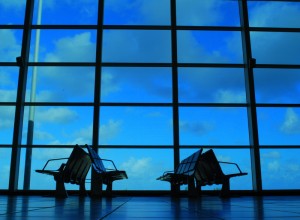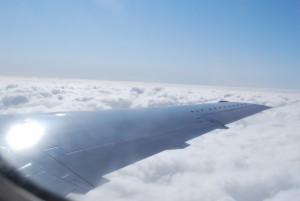By KATHERINE GUEST
Ducking into the tight doorway of an Air Canada Airlines aircraft, David Page, a student at Carleton University in Ottawa, Canada, smiles at the flight attendants and continues to a nearby empty seat.
He turned off his cellphone after sending out a final text and pulled out his laptop to get to work on his term papers as well as his headphones for some peace and quiet beside the loud turbines outside his window seat.
“I don’t think it was even two minutes later that the flight attendant showed up and made me put my headphones back in my bag and turn my laptop all the off because hibernate mode wasn’t even allowed,” Page recalled.
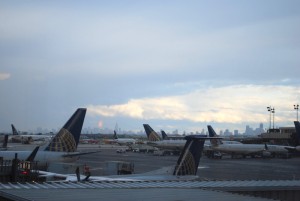
Overlooking the Continental Aircraft hub at Newark International Airport (Photo by Katherine Guest).
Page is not alone. About two million U.S. air travelers experience similar on-board enforcement activity each day. But it could all change soon.
The Federal Aviation Administration has decided to re-evaluate the rules regarding the use of some personal electronic devices on aircraft.
A panel of experts named the Aviation Rulemaking Committee began meeting in January and has continued to meet through the month of September.
For many people, although there is hassle involved, flying is an enjoyable experience with exciting prospects of going somewhere new or different. However, for the average business traveler or any person of today’s time that is rather attached to their personal electronics, flying can be a pain.
On most flights, flight attendants are equipped with hawk-like vision for anyone hiding an ear bud or screen under their hands and announce when all electronics must be turned off … about 14 times. The requirement that our precious screens and ringers must be put to sleep temporarily is really not that much of a request, but is a topic of debate among many when someone is finally brave enough to ask— “but, why?”
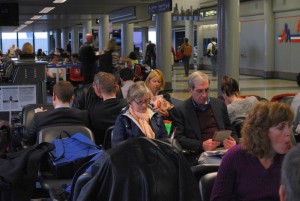
A couple uses their e-readers while waiting to board a plane in the Chicago O’Hare Airport (Photo by Katherine Guest).
It has been claimed for many years that the signals and transmitters within personal electronic devices (PEDs), not including cellphones, interrupt or interfere with the aircraft’s cockpit electronics.
In today’s age though, one would think that the cockpit’s electronics would be at least slightly more advanced than that of the average person’s laptop or e-reader.
“It was part of our training, just like giving instructions on life jackets, to instruct people to power everything down,” explained Barbara Hawks, a retired flight attendant for United Airlines now living in Mooresville, N.C. “It was a simple concept, but as cellphones and electronics became more advanced and people relied on them more, they complained when it came time to turn them off for take-off.”
In a 2003 study conducted by the Radio Technical Commission for Aeronautics, a non-profit organization that works under contract for the Federal Aviation Administration as well as the federal government, it was found that there is not enough hard evidence to prove that PEDs do not interfere with the cockpit.
This study did not, however, look at whether they have enough evidence to support that they do interfere but the television show Mythbusters did.
The infamous duo of the Discovery Channel program took it upon themselves to build a cockpit shack in a warehouse and test out PED’s and especially cellphones against the make-shift aviation equipment. No evidence of interference was found in the less rigorous test.
According to The New York Times report on the possible FAA regulation changes, Delta Airlines noted 21 safety reports by pilots that believed PEDs impeded the ability of their aircraft’s devices to work correctly. The airline was never able to prove this as fact but the reports were kept on file.
“I have never had it happen personally, but everybody knows the stories, they’re like ghost stories, your equipment just goes weird,” said Rob Hawks a senior international United Airlines pilot and husband to Barbara. “A pilot’s job is to fly the plane, the equipment is there to help so if something ever did go wrong I mean, that’s what I’m there for.”
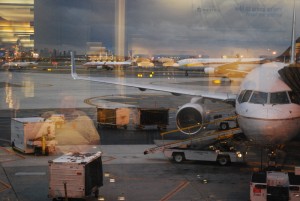
Passengers wait to board as a plane is refueled and loaded at Newark International Airport (Photo by Katherine Guest).
Cellphones are proven to be a device of interference. Since 1991, all airlines, under FAA rules, prohibit the use of cellphones at all on any flight except for during the final taxiing to the gate.
The problem is if someone is talking on their cellphone during landing or take-off, while pilots are still in direct contact with the airport’s ground control tower regarding the whereabouts of other planes, which conversation is the pilot going to hear?
“In all cockpits, there are charts that have the lengths of runways from every airport they would be landing at, so if, in theory, a plane was landing and there was no working communication with ground control then they could safely land. Assuming they know the weight of the plane, they’ll be able to manually calculate the landing speed they will need to land the plane within the allowed distance of the runway safely,” explained Breanna Hayton, an aerospace engineer and associate of the American Institute of Aeronautics and Astronautics based out of Miami.
With the introduction of airplane mode, some airlines have begun to allow passengers to use their phone in this setting when flying above 10,000 feet. The notion behind “the mode” is that it blocks the cellphone from being able to transmit signals that are what the FAA are concerned interferes with the cockpit.
According to the FAA release, the agency is debating the method in which the aircraft operators and airlines will test whether PEDs can be safely used on board and which PEDs can be used on board.
They are also considering the “standards of technology associated with the use of PEDs during any phase of flight.”
Following the investigation by the committee the report will be made to the FAA with recommendations for changes to current policy that are available and/or necessary. The bans that will continue unquestionably will include the use of Wi-Fi during the take-off and landing as well as the making a phone call at any point once boarded on the plane.
All changes that may occur will not be put into place next year.
Current Regulations
- The use of cellphones on board any aircraft until taxiing to the gate upon arrival at destination is strictly prohibited.
- The use of PEDs is prohibited with the exception of portable voice recorders, hearing aids, heart pacemakers, and electric shavers. The use of electronic devices that do not transmit signals (with the exception of on-board Wi-Fi) above 10,000 feet is allowed.
- All electronics must be turned completely off during take-off and landing.
Possible Modifications to Policy
It has been announced that all rules in regards to use of electronics during take-off, landing and during a flight will be relaxed. The actual guidelines will only be released once the FAA receives feedback regarding its current rules and regulations.

